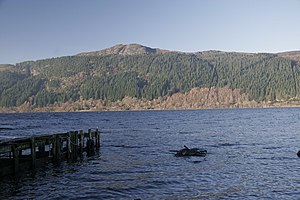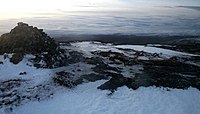Mealfourvounie: Difference between revisions
Created page with "{{Infobox hill |name=Mealfourvounie |gaelic=Meall-fuar-mhonaidh |picture=Meall Fuar-mhonaidh from Foyers - geograph.org.uk - 389846.jpg |picture caption=Mealfourvounie from Fo..." |
No edit summary |
||
| Line 2: | Line 2: | ||
|name=Mealfourvounie | |name=Mealfourvounie | ||
|gaelic=Meall-fuar-mhonaidh | |gaelic=Meall-fuar-mhonaidh | ||
|county=Inverness-shire | |||
|group= | |||
|picture=Meall Fuar-mhonaidh from Foyers - geograph.org.uk - 389846.jpg | |picture=Meall Fuar-mhonaidh from Foyers - geograph.org.uk - 389846.jpg | ||
|picture caption=Mealfourvounie from Foyers | |picture caption=Mealfourvounie from Foyers | ||
| Line 40: | Line 42: | ||
{{reflist}} | {{reflist}} | ||
*F H Groome, Ordnance Gazetteer of Scotland (1882-4); 2004 Gazetteer for Scotland | *F H Groome, Ordnance Gazetteer of Scotland (1882-4); 2004 Gazetteer for Scotland | ||
Latest revision as of 22:42, 7 April 2015
| Mealfourvounie | |
| Inverness-shire | |
|---|---|
 Mealfourvounie from Foyers | |
| Summit: | 2,293 feet 57°15’53"N, 4°33’37"W |
Mealfourvounie, also known by the Gaelic Meall-fuar-mhonaidh ("mountain of the cold moor"), is a mountain rising dramatically above the north shore of Loch Ness in Inverness-shire , southwest of Drumnadrochit and Urquhart Castle, and opposite Foyers across the loch, from where the mountain is much admired. It stands at 2,293 feet.
The mountain gained great fame in the great days of the Highland holiday: to those who came in the nineteenth century for a rugged Highland holiday, filling the hostels of Drumnadrochit and Fort Augustus, this great mountain rising above Loch Ness and between the two centres was a draw, and guidebooks gave directions on the best climbs.
Accounts
In the account of Lucy Ward, one of the intrepid Ward sisters, wrote in Tait's Edinburgh Magazine Mealfourvounie as an "immense and shapely mountain rising from Loch Ness", and that of all the district of Inverness:
"Mealfourvounie is ever one of the most attractive objects, rising over the other mountain heights in the direction of the Great Glen, like St Paul's among the infinity of the lesser domes and turrets of London city."[1]
The size of the mountain has given rise to much confusion. Early works assert that Mealfourvounie is, with Ben Nevis, one of the principal mountains of Inverness-shire; in 1829 The Traveller's Guide Through Scotland it is amongst the few mountains named for the county, and Mealfourvounie's height is put at 3,006 feet,[2] more than 700 feet above its measured height.
The mountain forms a conspicuous feature on the northwest flank of Loch Ness. It is broad-based and roundbacked, and sends up from a stage at two-thirds of its whole elevation a dome-shaped peak to the summit.
Loch nam Breac Dearga
Loch nam Breac Dearga is a large tarn atop the mountain. Legend tells that it is bottomless,[3] though hydrographers disagree.

Geology and geography
The great mass of the mountain, from the summit downward, consists of coarse conglomerate, whose abraded portions are gneiss, granite, quartz, mica-schist, and sandstone, cohering with extremely little cement; and its lower declivities, including seemingly the entire base, consist of a hard compact splintery rock, which has usually been described as primary red quartz, but which may be stratified sandstone completely indurated, and in great measure divested of its stratification by the subjacency of granite, and which is so hard and crystalline as to be quarried and regularly used for causewaying the streets of Inverness.
The upper stage or peak of the mountain is very steep on the west, and almost mural on the north and south; and it is connected with the rest of the mountain, on the east, by a long tapering ridge.
On the western side, at the bottom of the peak, is Loch nam Breac Dearga and from this lake a streamlet runs 4¼ miles southwards to Loch Ness, tumbling along a broken channel down the face of a frontlet of rock, overshadowed by trees in its lower course, and forming two beautiful waterfalls amidst foliage of the richest tints.
Summit
The view from the summit of Mealfourvounie is grand and extensive, and comprehends the whole of the Glenmore-nanAlbin, from Fort George on the northeast to Fort William on the southwest, a distance of more than 70 miles.
Outside links
References
- ↑ Tait's Edinburgh Magazine - Tours and Detours in Scotland, in the Summer of 1836 by the Wards of Clapham
- ↑ The Traveller's Guide Through Scotland, 1829
- ↑ Folklore of Scottish lochs and springs – James M Mackinlay (1893)
- F H Groome, Ordnance Gazetteer of Scotland (1882-4); 2004 Gazetteer for Scotland